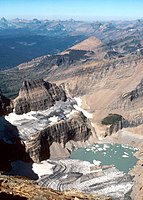
Retreat of glaciers since 1850
The retreat of glaciers since 1850 is well documented and is one of the effects of climate change. The retreat of mountain glaciers provide evidence for the rise in global temperatures since the late 19th century. Examples include mountain glaciers in western North America, Asia, the Alps in central Europe and tropical and subtropical regions of South America and Africa. Since glacial mass is affected by long-term climatic changes, e.g., precipitation, mean temperature, and cloud cover, glacial mass changes are one of the most sensitive indicators of climate change. Retreat of glaciers is also a major reason for sea level rise. Excluding peripheral glaciers of ice sheets, the total cumulated global glacial losses over the 26-year period from 1993 to 2018 were likely 5500 gigatons, or 210 gigatons per yr.[1]: 1275
"Glacier retreat" redirects here. For other uses, see Glacier retreat (disambiguation).
On Earth, 99% of glacial ice is contained within vast ice sheets (also known as "continental glaciers") in the polar regions. Glaciers also exist in mountain ranges on every continent other than the Australian mainland, including Oceania's high-latitude oceanic island countries such as New Zealand. Glacial bodies larger than 50,000 km2 (19,000 sq mi) are called ice sheets.[2] They are several kilometers deep and obscure the underlying topography.
Deglaciation occurs naturally at the end of ice ages. But the current glacier retreat is accelerated by global warming due to human-caused greenhouse gas emissions. Human activities since the start of the industrial era have increased the concentration of carbon dioxide and other heat-trapping greenhouse gases in the air, causing current global warming.[3] Human influence is the principal driver of changes to the cryosphere of which glaciers are a part.[3]
The glacier mass balance is the key determinant of the health of a glacier. If the amount of frozen precipitation in the accumulation zone exceeds the quantity of glacial ice lost due to melting or in the ablation zone a glacier will advance. If the accumulation is less than the ablation, the glacier will retreat. Glaciers in retreat will have negative mass balances. If they do not find an equilibrium between accumulation and ablation, they will eventually disappear.
Mid-latitude mountain ranges are showing some of the largest proportionate glacial losses. Examples for such mountain ranges are the Himalayas in Asia, Rocky Mountains in North America, the Alps in Europe, the Cascade Range in North America, Southern Alps in New Zealand, the southern Andes in South America, as well as isolated tropical summits such as Mount Kilimanjaro in Africa.
Glacial ice is the largest reservoir of fresh water on Earth, holding with ice sheets about 69 percent of the world's freshwater.[4][5] The retreat of glaciers has near term impacts on the availability of fresh water for drinking water and irrigation. For example, in the Andes and Himalayas the demise of glaciers will affect water supplies for people in that region.[6] Melting glaciers also lead the sea level rise.
Measurement techniques[edit]
Methods for measuring retreat include staking terminus location, global positioning mapping, aerial mapping and laser altimetry.[14][16] The key symptom of disequilibrium is thinning along the entire length of the glacier. This indicates a diminishment of the accumulation zone. The result is marginal recession of the accumulation zone margin, not just of the terminus. In effect, the glacier no longer has a consistent accumulation zone and without an accumulation zone cannot survive.[15][17]
Management approaches[edit]
Reducing greenhouse gas emissions (i.e. climate change mitigation measures) is the only solution that addresses the root cause of glacier retreat since industrialization.
To retard melting of the glaciers some Austrian ski resorts partially covered portions of the Stubai and Pitztal Glaciers with plastic.[178] In Switzerland plastic sheeting is also used to reduce the melt of glacial ice used as ski slopes.[179] While covering glaciers with plastic sheeting may prove advantageous to ski resorts on a small scale, this practice is not expected to be economically practical on a much larger scale.



